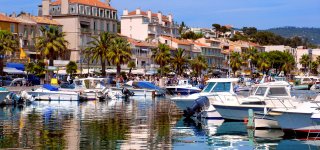City Bandol
Village on the Mediterranean already present in the Neolithic, Bandol disappears at the end of antiquity because of the barbarian invasions, when the coastal inhabitants were forced to flee to the interior. The Bandol site will be reinvested until later in the 16th century, at the end of the religious wars. A fort is built there, Henry IV provides a valiant soldier, Antoine Boyer, a reward for his loyalty and courage. The man was knighted, and his family in 1715 will create a new village around the fort, consisting of seven pioneer homes. The culture of the vine allows rapid development of Bandol. From the late 18th century, the local wines are celebrated at the Louis XV table.
Located in a natural setting between the Mediterranean beaches and hills, Bandol still retains the charm of the coastal village it was in the 18th century around the church Saint-François-de-Sales and its port historically linked to trade wine. Today marina, it still houses some sharp varying colors, iconic traditional fishing boats in the Mediterranean.
An attractive destination, attracted Bandol for treasures concealed its seaside coastline, as for the richness of its soil, the freshness of its parks and promenades, and the authenticity of its markets.
The beautiful bay of Bandol was during the 18th and 19th century the port of departure for exports of table wines produced locally. These wines of the vineyards of Provence benefit from the AOC since 1941. Their production for geographical base 1500 hectares around Bandol, extending the Massif de la Sainte Baume to the sea. Mostly rosé wines of Bandol also include red high quality and a low proportion of whites. To discover them, nothing like a relaxing moment on the terrace of a restaurant of the coast! Several areas of the vineyard also offers tours with walk in the vineyards, cellars and tasting discovery.
The Bandol charming heritage is coming at once from its past coastal village of the 18th, and its development as a resort in the early 20th: we discover, strolling, its 18th church, bandstand of thirties, the remarkable belfry bell tower, its urban art, or its beautiful facades heritage-listed 20th century.
In Barry's Beach, a plaque commemorates the place in 1943 hosted the first of scuba tests created by the pioneers of diving Cousteau, Trim and Dumas.
Ideal for an afternoon exotic and refreshing family, the exotic garden and zoo of Sanary-Bandol home to many varieties of tropical plants and cacti, as well as mammals, reptiles and exotic birds.
Facing Bandol finally the long uninhabited island of Bendor was bought in 1950 by Paul Ricard, creator of the eponymous pastis. It forms with the Embiez Island, home to the Paul Ricard Oceanographic Institute, the duo which is called the "Paul Ricard islands". The contractor has given life to the island by making build a hamlet, a port, and recreational facilities. Popular in the 60s for its festivals and jazz evenings, she receives artists of all stripes as Josephine Baker, Luis Mariano, Dali, Fernandel or Dutronc. Just 150 meters from the port of Bandol, the island joined within minutes by shuttle boat. Dotted with works of art, it also houses a museum of wine and spirits, an art gallery and theater Vincent Scotto.
